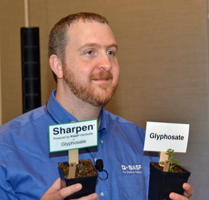 One of the facts presented at last week’s BASF grower symposium that surprised me was that only about half the growers in this country are concerned about weed resistance. But, BASF Herbicide Technical Market Manager Luke Bozeman says that has increased tremendously in recent years and will keep increasing. “We’re seeing a greater recognition of the impact of resistant weeds and those growers that haven’t yet experienced it are learning from their neighbors that it can be a problem,” he said.
One of the facts presented at last week’s BASF grower symposium that surprised me was that only about half the growers in this country are concerned about weed resistance. But, BASF Herbicide Technical Market Manager Luke Bozeman says that has increased tremendously in recent years and will keep increasing. “We’re seeing a greater recognition of the impact of resistant weeds and those growers that haven’t yet experienced it are learning from their neighbors that it can be a problem,” he said.
Because of that, BASF Crop Protection has been very proactive in getting new sites of action (SOA) on the market for growers to fight resistance and now has half of the current 24 registered SOAs. “Quite a range of products that can be utilized to control weeds on the growers’ fields,” he said.
Luke explains more in this interview: Luke Bozeman, BASF
 We talk about sites and modes of action when it comes to weed control, but BASF’s Greg Arnell says they are not the same. “We often use those interchangeably and that’s not right,” Greg explained. “Mode of action tells you how a herbicide kills a weed, site of action tells you where the herbicide kills the weed, what target site it’s actually hitting.”
We talk about sites and modes of action when it comes to weed control, but BASF’s Greg Arnell says they are not the same. “We often use those interchangeably and that’s not right,” Greg explained. “Mode of action tells you how a herbicide kills a weed, site of action tells you where the herbicide kills the weed, what target site it’s actually hitting.”
Greg says BASF has the MOST sites of action in the industry, the STRONGEST herbicides and the most FLEXIBLE. Among the herbicides BASF offers are those powered by Kixor, including Verdict, Optill and Sharpen.
Listen to my interview with Greg here: Greg Arnell, BASF
